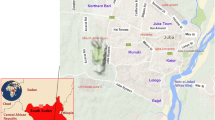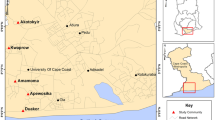Abstract
This study aims to assess the relationship between chemical and microbial contamination of groundwater sources and a range of potential hazards in two peri-urban areas of Kisumu, Kenya where shallow wells and pit latrines are widely used. From 1998 to 2004, 263 samples were taken from 61 groundwater sources and tested for thermotolerant coliforms. Eighteen of these sources were also tested for chemical contaminants, including nitrate, chloride and fluoride. The locations of all water sources, buildings and pit latrines in the study area were surveyed. Local pit latrine densities were calculated using a geographic information system. Ten out 18 samples were above the World Health Organization guideline values for nitrate, 236 out of 263 were positive for thermotolerant coliforms, and all were above the guideline values for fluoride. There was neither a relationship between thermotolerant coliform levels and daily rainfall patterns nor with sanitary risk inspection scores for samples from shallow wells (r = 0.01, p = 0.91, n = 191). The density of pit latrines within a 100-m radius was significantly correlated with nitrate and chloride levels (r = 0.64, p = 0.004 and r = 0.46, p = 0.05, respectively) but not with thermotolerant coliforms (r = 0.22, p = 0.11). These results illustrate both the public health risks associated with shallow groundwater sources, on-site sanitation and high population density. These findings have implications for current policies that promote latrine construction, especially in peri-urban areas of high population density. More comprehensive studies of larger communities should be commissioned to extend this analysis of the links between latrine density and groundwater contamination and so identify the contingent policy risks.






Similar content being viewed by others
References
Amini, M., Mueller, K., Abbaspour, K. C., Rosenberg, T., Afyuni, M., Moller, K. N., et al. (2008). Statistical modeling of global geogenic fluoride contamination in groundwaters. Environmental Science & Technology, 42, 3662–3668.
ARGOSS. (2001). Guidelines for assessing risk to groundwater from on-site sanitation. BGS Commissioned Report CR/01/42. Wallingford: British Geological Survey.
Central Bureau of Statistics. (2001). Kenya population census, 1999. Vol. 1. Ministry of planning and national development, government of Kenya. Nairobi: Government Printer.
Cotton, A., Franceys, R., Pickford, J., & Saywell, D. (1995). On-plot sanitation in low-income urban communities: a review of the literature. Loughborough: WEDC.
Cronin, A. A., Breslin, N., Gibson, J., & Pedley, S. (2006). Monitoring source and domestic water quality in parallel with sanitary risk identification in Northern Mozambique to prioritise protection interventions. Journal of Water and Health, 4, 333–346.
Cronin, A. A., Hoadley, A. W., Gibson, J., Breslin, N., Komou, F. K., Haldin, L., et al. (2007). Urbanisation effects on groundwater chemical quality: findings focusing on the nitrate problem from 2 African cities reliant on on-site sanitation. Journal of Water and Health, 5, 441–454.
DHV Consulting Engineers. (1987). Rural domestic water supply and sanitation programme. Water resources survey and training programme. Report on Nyakach Division. Ammersfoort: DHV Consulting Engineers.
Drangert, J. O., Okotto-Okotto, J., Okotto, L. G. O., & Auko, O. (2002). Going small when the city grows big: new options for water supply and sanitation in rapidly expanding urban areas. Water International, 27, 354–363.
Haruna, R., Ejobi, F., & Kabagambe, E. K. (2005). The quality of water from protected springs in Katwe and Kisenyi parishes, Kampala City, Uganda. African Health Sciences, 5, 14–20.
Howard, G., Pedley, S., Barrett, M., Nalubega, M., & Johal, K. (2003). Risk factors contributing to microbiological contamination of shallow groundwater in Kampala, Uganda. Water Research, 37, 3421–3429.
KNBS. (2011). Kenya national bureau of statistics. http://www.knbs.ke. Accessed 1 December 2011.
Kulabako, N. R., Nalubega, M., & Thunvik, R. (2007). Study of the impact of land use and hydrogeological settings on the shallow groundwater quality in a peri-urban area of Kampala, Uganda. Science of the Total Environment, 381, 180–199.
Luby, S. P., Gupta, S. K., Sheikh, M. A., Johnston, R. B., Ram, P. K., & Islam, M. S. (2008). Tubewell water quality and predictors of contamination in three flood-prone areas in Bangladesh. Journal of Applied Microbiology, 105, 1002–1008.
Mara, D. (1984). The design of ventilated improved pit latrines. World bank TAG technical note 13. Washington: The International Bank for Reconstruction and Development/the World Bank.
Moran, P. A. P. (1950). Notes on continuous stochastic phenomena. Biometrika, 37, 17–23.
Nair, K. R., Manji, F. & Gitonga, J. N. (1984). The occurrence and distribution of fluoride in groundwaters of Kenya. Challenges in African Hydrology and Water Resources. Proceedings of the Harare Symposium. International Association of Hydrological Sciences Publication No. 144
Naturgerechte Technologien. (2000). Basic sanitation and human excreta disposal in latrines. GTZ Gate Technical Information W9e. http://www.watersanitationhygiene.org/References/EH_KEY_REFERENCES/SANITATION/General%20Sanitation%20References/Basic%20Excreta%20Disposal%20(GTZ).pdf. Accessed 4 January 2012.
Okotto-Okotto, L. G. O. (1999). A preliminary assessment of groundwater recharge and well yields in peri-urban Manyatta and Migosi of Kisumu-Kenya. Kisumu Ecological Sanitation and Well Water Project (KESAWWA), final report, part II. Kisumu: Osienala and University of Linköping.
Pujari, P. R., Nanoti, M., Nitnaware, V. C., Khare, L. A., Thacker, N. P., & Kelkar, P. S. (2007). Effect of on-site sanitation on groundwater contamination in basaltic environment: a case study from India. Environmental Monitoring and Assessment, 134, 271–278.
Reddy, D. V., Nagabhushanam, P., & Peters, E. (2011). Village environs as source of nitrate contamination in groundwater: a case study in basaltic geo-environment in central India. Environmental Monitoring and Assessment, 174, 481–492.
United Nations Department of Economic and Social Affairs/Population Division. (2010). World urbanization prospects: the 2009 revision. New York: United Nations.
WHO. (1997). Guidelines for drinking-water quality, Vol. 3: surveillance and control of community supplies (2nd ed.). Geneva: World Health Organization.
WHO. (2011). Guidelines for drinking-water quality (4th ed.). Geneva: World Health Organization.
Xie, P. P., & Arkin, P. A. (1996). Analyses of global monthly precipitation using gauge observations, satellite estimates, and numerical model predictions. Journal of Climate, 9, 840–858.
Xu, Y., & Usher, B. (2006). Groundwater pollution in Africa. Leiden: Taylor & Francis/Balkema.
Acknowledgments
This study was originally funded by the US Environmental Protection Agency through a project entitled ‘virus analysis of shallow African groundwaters’ (ref: R-82860301-0). The authors wish to acknowledge the role of the University of Linkoping, Sweden who also participated in the study.
Author information
Authors and Affiliations
Corresponding author
Rights and permissions
About this article
Cite this article
Wright, J.A., Cronin, A., Okotto-Okotto, J. et al. A spatial analysis of pit latrine density and groundwater source contamination. Environ Monit Assess 185, 4261–4272 (2013). https://doi.org/10.1007/s10661-012-2866-8
Received:
Accepted:
Published:
Issue Date:
DOI: https://doi.org/10.1007/s10661-012-2866-8




